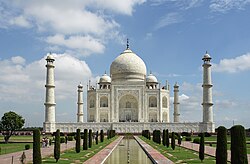The Mystery Behind the Construction of the Taj Mahal
Wonders of Construction Engineering in the Mughal Era
The Taj Mahal is one of the world’s most Iconic buildings, built by the Mughal Emperor Shah Jahan in the 17th century as a mausoleum for his wife, Mumtaz Mahal. Although widely known as a symbol of love, there are many mysteries surrounding the construction and design of this monument.
One of the most interesting aspects is the Wonders of Construction Engineering during the Mughal Era. The construction technology of that time may have seemed simple, but the Mughal engineers managed to create structures that were both magnificent and long-lasting. The construction of the Taj Mahal involved thousands of workers who utilized a system of ropes and pulleys to lift large blocks of marble. They used advanced scaffolding techniques to construct the main dome, which is the focal point of the entire design. This huge dome remains intact to this day, reflecting the skill of Mughal architecture.
Additionally, the use of perfect symmetry in every aspect of the building gives the impression of balance and tranquility. This is not only limited to the architecture, but also appears in the layout of the surrounding gardens and ponds. The placement of these elements shows careful planning and a mastery of geometric technique.
Not only that, the choice of materials for the Taj Mahal also reflects the luxury of the Mughal era. White marble imported from Makrana, Rajasthan, combined with precious stones from various parts of the world, adds to the visual beauty of this building.
All these engineering marvels, coupled with the dedication of thousands of workers, make the Taj Mahal one of the most impressive buildings in world architectural history.
Symbolic Meaning in Every Architectural Element of the Taj Mahal
The Taj Mahal is not just a magnificent monument, but also a work of art full of meaning. Built by Shah Jahan in memory of his wife, Mumtaz Mahal, every architectural element in the Taj Mahal has deep symbolism. The Symbolic Meaning of Every Architectural Element of the Taj Mahal depicts a message of love, eternity and harmony.
The perfect symmetry of this building reflects the balance in life and the universe. The building’s symmetrical structure, from the gardens to the main dome, is considered a symbol of cosmic order. Every angle and proportion was carefully designed to symbolize the inseparable unity between earth and heaven.
The main dome that rises high in the middle of the Taj Mahal is often interpreted as a symbol of the crown, which symbolizes power and majesty. This dome stands over the tomb chamber, showing the important role that Mumtaz Mahal had in Shah Jahan’s life. In fact, the dome’s reflection in the pool in front of it is thought to symbolize a reflection of the spiritual world.
The materials used also have meaning. White marble symbolizes purity and eternal love, while the precious stone decoration that covers the surface of the building gives the impression of luxury and heavenly beauty. Calligraphy of verses from the Koran carved at the entrance not only beautifies the building, but also emphasizes the spiritual connection between human love and the Creator.
With deep meaning in every detail, the Taj Mahal is not only a symbol of love, but also a representation of the philosophy and spirituality embedded in Mughal culture. Every architectural element, from the smallest to the most striking, has a deeper message than just physical beauty.
The Origins of the Taj Mahal Design: Influences from Diverse Cultures
The Taj Mahal is not only known for its beauty, but also for its unique blend of architecture. The Taj Mahal is the result of various cultural influences, reflecting the Design Origins of the Taj Mahal: Influences from Diverse Cultures. Designed during the heyday of the Mughal Empire, the building’s design combines elements from Indian, Persian and Islamic traditions.
From Indian traditions, we can see the use of marble and intricate carved details. The curved shape of the gate and the use of regular gardens reflect the influence of Persian culture, which placed great importance on symmetry and harmony in design. These gardens, known as “charbaghs,” are typical of Persian architecture, where the garden is divided into four parts as a symbol of heaven on earth.
The influence of Islam is clearly visible in the use of Al-Quran calligraphy that decorates the main entrances. In addition, the large dome that towers above the main tomb is reminiscent of the architecture of mosques in the Middle East. This dome, combined with the surrounding towers, gives the building a monumental and sacred impression.
The symbolism behind the design of the Taj Mahal also shows a mix of cultures. Shah Jahan, who had Mughal-Persian ancestry, wanted to create a monument that was not only physically beautiful, but also filled with spiritual and symbolic meaning from various traditions. Every element chosen, from materials, shapes, to decorations, reflects the influence of various cultures that blend in one harmonious unity.
Revealing the Legend of Shah Jahan and Mumtaz Mahal’s Love Behind the Taj Mahal
The Taj Mahal is not only known as an architectural masterpiece, but also as a symbol of eternal love. The story behind its construction is rooted in Revealing the Legend of Shah Jahan and Mumtaz Mahal’s Love Behind the Taj Mahal, which still amazes many people to this day.
Shah Jahan, the Mughal emperor, deeply loved his wife, Mumtaz Mahal, who was considered his true companion. Mumtaz, who died while giving birth to their 14th child, made Shah Jahan feel a deep sense of loss. In memory of his irreplaceable love, Shah Jahan ordered the construction of the Taj Mahal, a magnificent monument that reflects the beauty and grandeur of his feelings.
The construction of the Taj Mahal took more than two decades, involving thousands of workers and architects. This building was designed as a symbol of loyalty, with Mumtaz’s grave at its center as a symbol of eternal love. Interestingly, Shah Jahan himself was buried next to his wife, although his original plan was to build another mausoleum for her across the river.
Apart from the architectural aspect, the love legend of Shah Jahan and Mumtaz also lives in every carving and ornament on the Taj Mahal. The white marble used is thought to symbolize the purity of their love, while the symmetrical garden that surrounds it represents the serenity and harmony they once had together.
The Taj Mahal has now become a global symbol of true love that transcends time. Despite many of the more scientific aspects of history, the legend of the love between Shah Jahan and Mumtaz remains at the core of the meaning contained within this magnificent monument.




